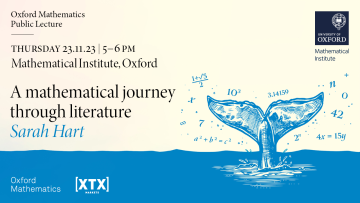In this Oxford Mathematics Public Lecture, Sarah will explore the many connections between mathematics and literature. She'll show the hidden mathematical structures behind everything from poetry to novels, and reveal some of the beautiful mathematical imagery and symbolism in fiction, from simple fairy tales to classics like Moby-Dick. Her goal is to show that not only are mathematics and literature inextricably linked, but that understanding these links can enhance our enjoyment of both.
Noncommutative geometry meets harmonic analysis on reductive symmetric spaces
Abstract
A homogeneous space G/H is called a reductive symmetric space if G is a (real) reductive Lie group, and H is a symmetric subgroup of G, meaning that H is the subgroup fixed by some involution on G. The representation theory on reductive symmetric spaces was studied in depth in the 1990s by Erik van den Ban, Patrick Delorme, and Henrik Schlichtkrull, among many others. In particular, they obtained the Plancherel formula for the L^2 space of G/H. An important aspect is that this generalizes the group case, obtained by Harish-Chandra, which corresponds to the case when G = G' x G' and H is the diagonal subgroup.
In our collaborative efforts with A. Afgoustidis, N. Higson, P. Hochs, Y. Song, we are studying this subject from the perspective of noncommutative geometry. I will describe this exciting new development, with a particular emphasis on describing what is new and how this is different from the traditional group case, i.e. the reduced group C*-algebra of G.


